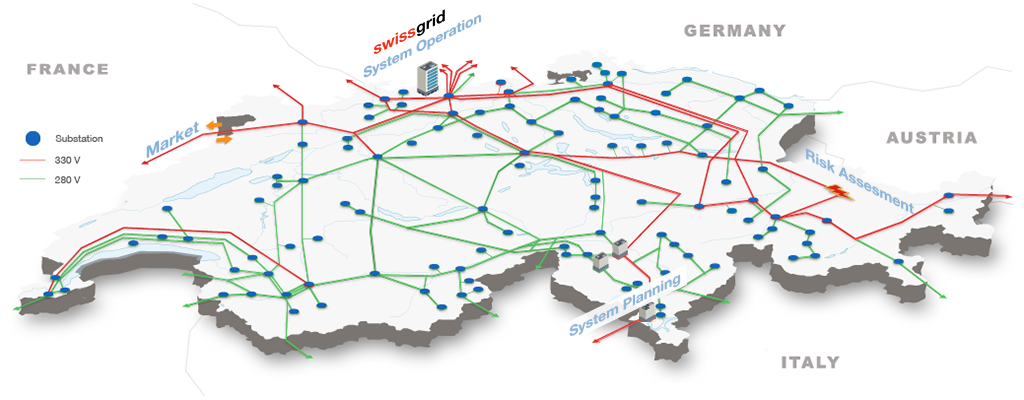
Innovation Challenges
For the planning, operation and economic evaluation of the Swiss energy system a realistic technical model is required, which must comprise:
- location of renewable generation and the limited predictability of these sources;
- location of storage devices, both large scale, i.e. pumped hydro storage, and distributed devices;
- interconnections with regional grids;
- interconnections on the bulk power level, i.e. high voltage lines and gas pipelines;
- possibility to interface it with models for market and other economic simulations
Currently, no state-of-the-art models can have all these features. They are often too simplistic, they neglect couplings between energy carriers, spatial properties are omitted, or large-scale systems cannot be optimized or simulated, to mention a few salient deficiencies.
Objectives
- The first objective of this work package is to develop a model of the Swiss bulk energy system to analyse realistic and detailed representations of the Swiss system that can be used for planning and operation purposes. This should incorporating interactions between different energy carriers, fluctuating energy sources, storage devices, demand side management, transmission grid, spatial distribution.
- The second objective is to couple this model with the economic model of the University of Basel (SCCER-CREST) and use it for concrete studies aiming at giving direct advice to various stakeholders and decision makers when planning the future Swiss energy system, such as new electrical market schemes.
- The third objective is to validate this model on real-cases in close collaboration with SwissGrid, the Swiss transmission grid operator.
Highlights
Optimization of the Swiss energy system
Software implementation and benchmark model of the Swiss power and energy system (Deliverable 2.1.2)
Academic partners: ETHZ FEN (Dr. Demiray); ETHZ PSL (Prof. Andersson); ZHAW IEFE (Prof. Korba); USI ICS (Prof. Schenk); Uni Basel FoNEW (Prof. Weigt); ETHZ LEC (Prof. Abhari), ETHZ RRE (Prof. Sansavini) and ETHZ IKZ (Prof. Raubal)
Further information: Prof. Dr. Göran Andersson (ETHZ, Power Systems Laboratory, [email protected]), Dr. Alexander Fuchs (ETHZ, Research Centre for Energy Networks, [email protected])
Industrial partner: SwissGrid
The main topic is the benchmark modeling and simulation of the Swiss Energy system, in particular the power transmission grid. The subtask investigates two aspects. First, an automatic model aggregation to obtain simple and tractable global models that guarantee the feasibility of the underlying complex regional models. Secondly, efficient optimization routines are developed to enable the long term planning with complex scenarios.
Innovation
The developed methods do not focus on specific results for a few selected scenarios but provide parametric planning results for a range of parameters, selected by the network planner or policy maker.
Impact
Today’s energy systems are largely operated independently between multiple regions and energy domains. The project will illustrate the potential of new unified operation techniques and can serve as a roadmap for the reorganization of the energy sector.
What’s next
The team will work on the integration of the aggregated model with the simulation tool for the quantitative evaluation of future energy scenarios.
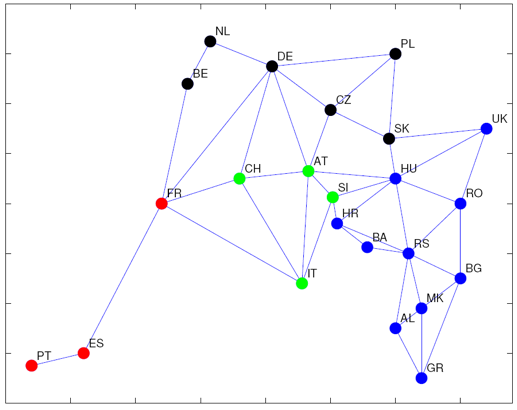 |
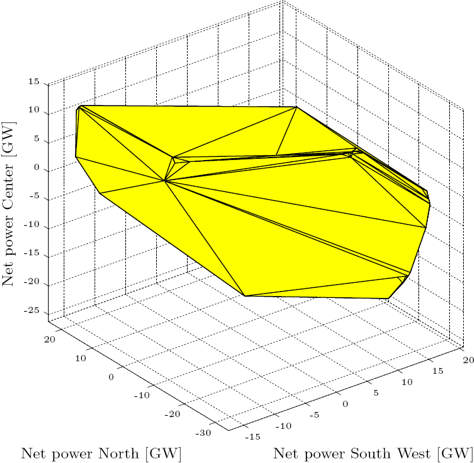 |
|
Figure 16: Map of the ENTSO-E system, aggregated from 9241 buses into 23 zones (circles) and into four large regions to illustrate cross border power exchanges: South-western (red), northern (black), central (green) and south-eastern region (blue).
|
Figure 17: Possible net power injections of the ENTSO-E system aggregated into four regions, projection of the full transmission line constraints. The feasible set of the south-western, northern and central region is shown. The south-eastern region is not shown and compensates the total power imbalance of the shown regions to zero. The polyhedral representations of admissible net power injections allows a fast feasibility assessment of the aggregated system model.
|
Coupling of load flows and economic models
Model of the linkage between dispatch and economic research results. (Deliverable 2.3.2)
Further information: Dr. Turhan Demiray, Dr. Jared Garrison (ETHZ, Research Center for Energy Networks, [email protected], [email protected])
Industrial partner: SwissGrid
The subtask team aims to develop the future Swiss electricity market ensuring accessibility and security of the underlying multi energy system. This study focuses on the integration of the technical energy grid model of the above-mentioned subtasks S2.1 (Modelling of large scale multi-energy systems) and S2.2 (Transmission system upgrade) with economic energy models as developed by project partners and in other SCCERs.
Innovation
The key contribution of this subtask is a greenfield study of the future integrated Swiss energy market, concerning power, both traditional and new, reserves and the integration with technical system operation constraints. The overall objectives are combined and co-optimized to provide a globally optimal approach to large-scale energy system operation.
Impact
The outcome of this task will provide an example of the potential system performance that can be reached with an integrated market approach. This can serve as a guideline for more detailed studies of the transition to future energy market structures.
What’s next
The results will be validated quantitatively by comparing them with existing studies, which are based on today’s market structures.
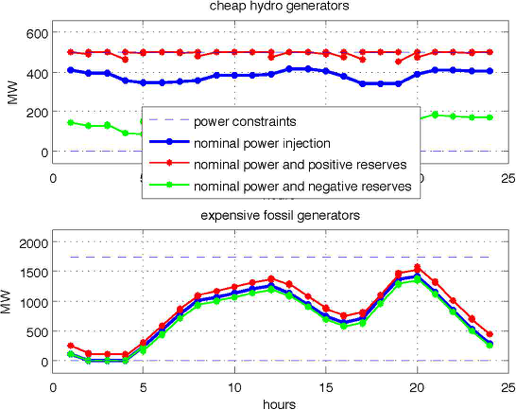 |
|
Figure 19: Cooptimization of power in reserves in a system with hydro and fossil generators, illustrating the operation of a future integrated energy market. The cheap and fast hydro cannot be fully used for power production because it is needed to meet the global reserve requirements. The power production is replaced by expensive fossil power plants that can make only limited contributions to the reserves.
|
Application of 3D GIS for transparent and sustainable planning of electric power systems
On-line 3D GIS-based tool for quick and robust planning of Transmission lines based on an objective multi-criteria approach
Academic partner: ETHZ (IKG) ( [email protected] ) Industrial partner: SwissGrid AG; BKW AG
Non-FURIES partners: ETHZ (PLUS), VERBUND Umwelttechnik GmbH
Funding: SFOE Project duration: 2014-2017 (3 years)
Defining the optimal path of transmission lines is a time consuming planning task, which is often impacted by strong social opposition. Furthermore, currently the planning involves experts-based multi-criteria approach which involves a risk of biased decisions.
Goal
The scope of this project is the development of an integrated 3D GIS web-platform to define the optimal path of a new transmission line, to enhance the communication among all stakeholders involved in a project and to reduce social opposition.
An improved 3D visualization to be utilized for community-based decision-making will demonstrate to the stakeholders the impact of the new project on the surroundings.
Results
In the frame of this project, a demo on-line planning tool for transmission lines siting was developed. This tool allows users to select the weights to assign to different geographical layers, e.g. protected areas, during the process of selection of the optimal transmission line path.
Automatic transmission line siting is done by gathering weights for geographical layers through expert knowledge. This increases the subjectivity of the analysis and bounds the results to the opinions of the experts involved. The tool developed here allows users to fully customize the decision making process, thus allowing for full control.
Next step
As a next step, the on-line tool will be further developed by expanding it beyond the test area.
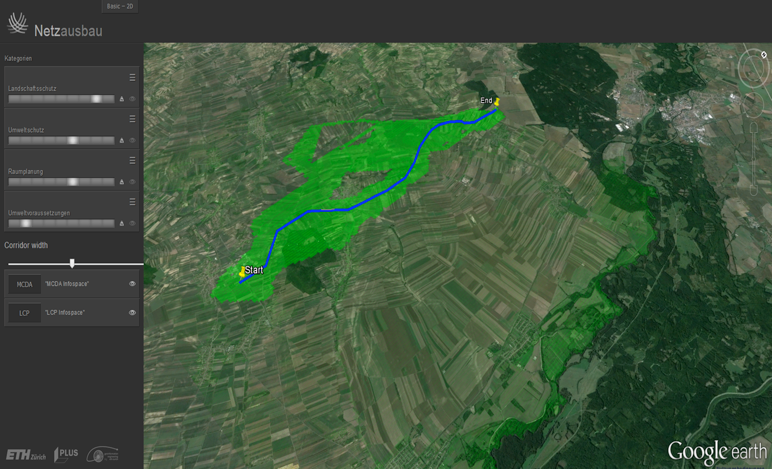 |
| Figure 26 – Screenshot of the optimal path for a transmission line generated by the on-line planning tool. |
Further reading: